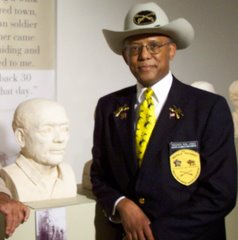
Did other codes left by Leonardo foretell the coming of a specific Buffalo Soldier? Let's take a look at the facts.
Fact: Leonardo was Catholic and my father, Trooper Frederic Douglass Jones, was Catholic.
Fact: Leonardo spoke Italian and Trooper Jones taught himself to speak Italian and was his squadron's interrupter when he served with the 92nd Infantry Division in Italy during WWII.
Fact: Leonardo painted the Mona Lisa in the early 1500's and Trooper Jones finished his painting of the Mona Lisa exactly 450 years later.
Fact: Leonardo Da Vinci is an anagram. If you rearrange the letters and then take a few of them out and add others, you get, Fred of Cincinnati, FACT!
Leonardo epitomized the 'Renaissance Man' because he excelled in the arts and sciences. Any of us who knew Trooper Jones knows that he also excelled in the arts and sciences and was without a doubt, a 'Renaissance Man.'
Fact: Leonardo died at the age of 66. In 1866 the Buffalo Soldiers were created by an act of Congress.
Trooper Jones was born in 1923. If you add 19 and 23 you get 42. Now add 4 plus 2 and you get 6. If you hold the number 6 next to a mirror you'll see two sixes, the one you're holding and the one in the mirror. Now, everyone knows that Leonardo practiced 'Mirror Writing,' so the clue here (with one of the 6's reversed in the mirror) is leading us back to Leonardo at the age of his death, which was, 66, FACT!
Not only that, but this clue is also telling us what year in the 1800's the Buffalo Soldiers would be organized, which of course was 1866, FACT!
* * * * * * * * * * * * * * * * * * * * * * * * * * * * * * * *
We have had a little fun here at the expense of the "DA VINCI CODE." With all the hype that was going on around the movie and the book, we just wanted to show you that Dan Brown isn't the only one who can have fun playing with the FACTS!
Trooper Jones was not unique among WWII Buffalo Soldiers. Just talk to Trooper Eugene Lewis, Trooper Waldo Henderson, Trooper Bruce Dennis, or Trooper Fred Cartha; have a chat with Trooper Andrew Isaacs, Trooper Royal Carter, Trooper Robert McDaniel, or Trooper James Cooper; sit down with Trooper Harold Cole, Trooper Ernest Collier, Trooper Henry Phillips, Trooper Alfred Evans, Trooper Robert Joyce Jr or any of the other surviving WWII, and Korean War Buffalo Soldiers. You will find that all of these men were ahead of their time, true 'Renaissance Men." How far could they have truly gone, in life, if not for the color of their skin?
Fact: Desertions among White regiments were roughly three times greater than those among the Buffalo Soldier units, during the Indian Wars. Also, both Black Cavalry and Infantry regiments had lower rates of alcoholism than their White counterparts.
Fact: The 9th and 10th Cavalries’ service in subduing Mexican revolutionaries, hostile Native Americans, outlaws, comancheros, and rustlers was as invaluable as it was unrecognized. It was also accomplished over some of the most rugged and inhospitable country in North America. A list of their adversaries – Geronimo, Sitting Bull, Victorio, Lone Wolf, Billy the Kid, and Pancho Villa – reads like a “Who’s Who” of the American West.
Fact: Lesser known, but equally important, the Buffalo Soldiers explored and mapped vast areas of the southwest and strung hundreds of miles of telegraph lines. They built and repaired frontier outposts around which future towns and cities sprang to life. Without the protection provided by the 9th and 10th Cavalries, crews building the ever expanding railroads were at the mercy of outlaws and hostile Indians. The Buffalo Soldiers consistently received some of the worst assignments the Army had to offer. They also faced fierce prejudice to both the colors of their Union uniforms and their skin by many of the citizens of the post-war frontier towns. Despite this, the troopers of the 9th and 10th Cavalries developed into two of the most distinguished fighting units in the Army.
Fact: Their 30 years of uninterrupted service in the western territories and frontier is the longest by any military unit in the history of the U.S. Army.
Imagine the protest that would be organized today if we left four regiments of the 1st Cavalry Division in Iraq for the next 30 years, with the same men who had little or no chance for reassignment because they could only be reassigned to another segregated regiment and those regiments were in Iraq already.
Can you imagine?








